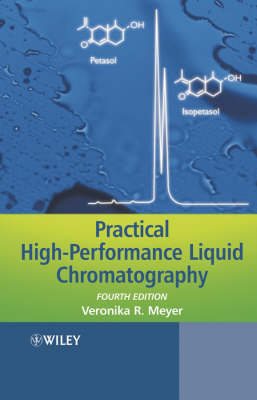
Practical High-Performance Liquid Chromatography
John Wiley & Sons Inc (Verlag)
978-0-470-09377-1 (ISBN)
- Titel erscheint in neuer Auflage
- Artikel merken
Veronika Meyer's book on HPLC is a classic text and remains one of the few titles available on general HPLC. Following on from the success of the previous three editions, this new, fourth edition continues to provide users of HPLC in industry, government, and service laboratories, as well as postgraduate students, with a unified approach to HPLC and an equal treatment of the theory and practice of this important technique. The contents of this edition have been revised, expanded and updated. Where available, old literature references have been replaced by recent ones. New sections on the following topics have been included: shelf-live of mobile phases; the mixing cross; phase systems in ion chromatography; and measurement uncertainty.
From the Preface to the First Edition. Preface to the Fourth Edition. Important and Useful Equations for HPLC. 1 Introduction. 1.1 HPLC: A powerful separation method. 1.2 A first HPLC experiment. 1.3 Liquid chromatographic separation modes. 1.4 The HPLC instrument. 1.5 Safety in the HPLC laboratory. 1.6 Comparison between high--performance liquid chromatography and gas chromatography. 1.7 Pressure units. 1.8 Length units. 1.9 Scientific journals. 1.10 Recommended books. 2 Theoretical Principles. 2.1 The chromatographic process. 2.2 Band broadening. 2.3 The chromatogram and its purport. 2.4 Graphical representation of peak pairs with different degrees of resolution. 2.5 Factors affecting resolution. 2.6 Extra--column volumes (dead volumes). 2.7 Tailing. 2.8 Peak capacity and statistical resolution probability. 2.9 Effects of temperature in HPLC. 2.10 The limits of HPLC. 3 Pumps. 3.1 General requirements. 3.2 The short--stroke piston pump. 3.3 Maintenance and repair. 3.4 Other pump designs. 4 Preparation of Equipment up to Sample Injection. 4.1 Selection of mobile phase. 4.2 Preparation of the mobile phase. 4.3 Gradient systems. 4.4 Capillary tubing. 4.5 Fittings. 4.6 Sample injectors. 4.7 Sample solution and sample volume. 5 Solvent Properties. 5.1 Table of organic solvents. 5.2 Solvent selectivity. 5.3 Miscibility. 5.4 Buffers. 5.5 Shelf--life of mobile phases. 5.6 The mixing cross. 6 Detectors. 6.1 General. 6.2 UV detectors. 6.3 Refractive index detectors. 6.4 Fluorescence detectors. 6.5 Electrochemical (amperometric) detectors. 6.6 Light scattering detectors. 6.7 Other detectors. 6.8 Multiple detection. 6.9 Indirect detection. 6.10 Coupling with spectroscopy. 7 Columns and Stationary Phases. 7.1 Columns for HPLC. 7.2 Precolumns. 7.3 General properties of column packings. 7.4 Silica. 7.5 Chemically modified silica. 7.6 Styrene--divinylbenzene. 7.7 Some other stationary phases. 7.8 Column care and regeneration. 8 HPLC Column Tests. 8.1 Simple tests for HPLC columns. 8.2 Determination of particle size. 8.3 Determination of breakthrough time. 8.4 The test mixture. 8.5 Dimensionless parameters for HPLC column characterization. 8.6 The van Deemter equation from reduced parameters and its use in column diagnosis. 8.7 Diffusion coefficients. 9 Adsorption Chromatography. 9.1 What is adsorption? 9.2 The eluotropic series. 9.3 Selectivity properties of the mobile phase. 9.4 Choice and optimization of the mobile phase. 9.5 Applications. 10 Reversed--Phase Chromatography. 10.1 Principle. 10.2 Mobile phases in reversed--phase chromatography. 10.3 Solvent selectivity and strength. 10.4 Stationary phases. 10.5 Method development in reversed--phase chromatography. 10.6 Applications. 10.7 Hydrophobic interaction chromatography. 11 Chromatography with Chemically Bonded Phases. 11.1 Introduction. 11.2 Properties of some stationary phases. 12 Ion--Exchange Chromatography. 12.1 Introduction. 12.2 Principle. 12.3 Properties of ion exchangers. 12.4 Influence of the mobile phase. 12.5 Special possibilities of ion exchange. 12.6 Practical hints. 12.7 Applications. 13 Ion--Pair Chromatography. 13.1 Introduction. 13.2 Ion--pair chromatography in practice. 13.3 Applications. 13.4 Appendix: UV detection using ion--pair reagents. 14 Ion Chromatography. 14.1 Principle. 14.2 Suppression techniques. 14.3 Phase systems. 14.4 Applications. 15 Size--Exclusion Chromatography. 15.1 Principle. 15.2 The calibration chromatogram. 15.3 Molecular mass determination by means of size--exclusion chromatography. 15.4 Coupled size--exclusion columns. 15.5 Phase systems. 15.6 Applications. 16 Affinity Chromatography. 16.1 Principle. 16.2 Affinity chromatography as a special case of HPLC. 16.3 Applications. 17 Choice of Method. 18 Solving the Elution Problem. 18.1 The elution problem. 18.2 Solvent gradients. 18.3 Column switching. 18.4 Optimization of an isocratic chromatogram using four solvents. 18.5 Optimization of the other parameters. 18.6 Mixed stationary phases. 19 Analytical HPLC. 19.1 Qualitative analysis. 19.2 Trace analysis. 19.3 Quantitative analysis. 19.4 Recovery. 19.5 Peak--height and peak--area determination for quantitative analysis. 19.6 Integration errors. 19.7 The detection wavelength. 19.8 Apparatus test, validation and system suitability test. 19.9 Measurement uncertainty. 19.10 Derivatization. 19.11 Unexpected peaks: ghost and system peaks. 20 Preparative HPLC. 20.1 Problem. 20.2 Preparative HPLC in practice. 20.3 Overloading effects. 20.4 Fraction collection. 20.5 Recycling. 20.6 Displacement chromatography. 21 Separation of Enantiomers. 21.1 Introduction. 21.2 Chiral mobile phases. 21.3 Chiral liquid stationary phases. 21.4 Chiral solid stationary phases. 21.5 Indirect separation of enantiomers. 22 Special Possibilities. 22.1 Micro and capillary HPLC. 22.2 High--speed and super--speed HPLC. 22.3 HPLC with supercritical mobile phases. 22.4 Electrochromatography. 23 Appendix 1: Applied HPLC Theory. 24 Appendix 2: How to Perform the Instrument Test. 24.1 Introduction. 24.2 The test procedure. 24.3 Documentation, limiting values and tolerances. 25 Appendix 3: Troubleshooting. 26 Appendix 4: Column Packing. Index of Separations. Index.
| Erscheint lt. Verlag | 3.11.2004 |
|---|---|
| Zusatzinfo | Illustrations |
| Verlagsort | New York |
| Sprache | englisch |
| Maße | 167 x 237 mm |
| Gewicht | 670 g |
| Einbandart | gebunden |
| Themenwelt | Naturwissenschaften ► Chemie ► Analytische Chemie |
| ISBN-10 | 0-470-09377-3 / 0470093773 |
| ISBN-13 | 978-0-470-09377-1 / 9780470093771 |
| Zustand | Neuware |
| Haben Sie eine Frage zum Produkt? |
aus dem Bereich



